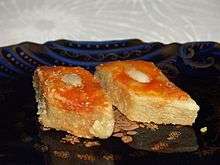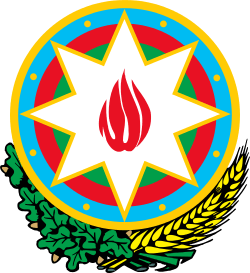Azerbaijani cuisine
| Part of a series on |
| Azerbaijanis |
|---|
| Culture |
| Traditional areas of settlement |
| Diaspora |
| Religion |
| Language |
| Persecution |
|
Azerbaijani cuisine (Azerbaijani: Azərbaycan Mətbəxi, آذربایجان مطبخی) refers to the cooking styles and dishes of the Azeri in Azerbaijan republic and Iranian Azerbaijan. Its cuisine has a lot in common with Iranian and Turkish cuisine. Many foods that are indigenous to the country can now be seen in the cuisines of other neighboring cultures. For the Azerbaijanis, food is an important part of their culture and is deeply rooted in the history, traditions and values.
Out of 11 climate zones known in the world, the Azerbaijani climate has nine.[1] This contributes to the fertility of the land, which in its turn results in the richness of the cuisine.
History
It is famous for vegetables and greens used seasonally in the dishes. Fresh herbs, including mint, coriander, dill, basil, parsley, tarragon, leek, chive, thyme, marjoram, green onion, and watercress are very popular and often accompany main dishes. The Caspian Sea is home to many edible species of fish, including the sturgeon, Caspian salmon, kutum, sardines, grey mullet, and others. Black caviar from the Caspian Sea is one of Azerbaijan’s best known delicacies well sought after in other parts of the world, including former Soviet countries.
One of the most reputed dishes of Azerbaijani cuisine is plov from saffron-covered rice, served with various herbs and greens, a combination totally distinct from those found in Uzbek plovs. Azerbaijani cuisine includes more than 40 different plov recipes. Other second courses include a wide variety of kebabs and shashlik, including lamb, beef, chicken, duck and fish (baliq) kebabs. Sturgeon, a common fish, is normally skewered and grilled as a shashlik, being served with a tart pomegranate sauce called narsharab. Dried fruits and walnuts are used in many dishes. The traditional condiments are salt, black pepper, sumac, and especially saffron, which is grown domestically on the Absheron Peninsula.
Black tea is the national beverage, and is drunk after food is eaten. It is also offered to guests as a gesture of welcome, often accompanied by fruit preserves.[2]
Light snacks
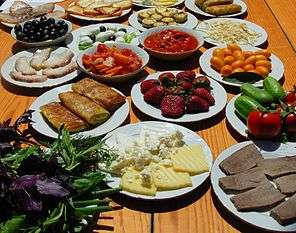
Azerbaijani cuisine has a number of light snacks and side dishes to open or accompany the main meals: a plate of aromatic green leaves called goy, pieces of chorek (bread), choban (a tomato and cucumber salad), and sometimes white cheese or qatik (sour yogurt).
Cold snacks are generally served separately from the drinks.
Dishes
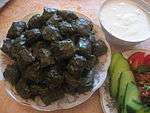

Main dishes may include a selection of the following:
Meat
| Name | Description |
|---|---|
| Balıq | Fish, usually sturgeon, normally skewered and grilled as a kebab, is served with a tart sour-plum sauce. |
| Dolma | The traditional recipe calls for minced lamb mixed with rice and flavoured with mint, fennel, and cinnamon, and wrapped in vine leaves (yarpaq dolması) or cabbage leaves (kələm dolması). There are also sour sweet cabbage dolma (turş şirin kələm dolması) and fish dolma (balıq dolması). |
| Badımcan Dolması | Tomato, sweet pepper, and aubergine stuffed with minced lamb mixed with chickpeas. |
| Dushbara | Small dumplings stuffed with minced lamb and herbs, served in broth. |
| Lavangi | stuffed chicken or fish with onions, walnuts, raisins, albukhara and alcha seasoning. A speciality of the Talysh region in southern Azerbaijan, but very difficult to find common in restaurants. |
| Lyulya kabab | A mixture of mutton, herbs, and spices squeezed around a skewer and barbecued, often served with lavash (thin sheets of unleavened bread). |
| Qutab | A sort of pancake turnover stuffed with minced lamb, cheese, or spinach. |
| Tika kabab | Chunks of lamb marinated in a mixture of onion, vinegar, and pomegranate juice, impaled on a large skewer and grilled on the barbecue. In Russian, called шашлык, from Turkic shishlyk (literally, "for skewer"). |
| Qovurma | Pieces of mutton or lamb on the bone (blade chops) stewed with onions, tomatoes, and saffron.[3] There is also sabzi qovurma, a lamb stew with herbs. |
| Sogan dolmasi | The term dolma covers a variety of stuffed vegetable dishes, widespread in the Middle East and the Mediterranean. Onion dolma are a tasty winter alternative to stuffed aubergines, tomatoes, and peppers.[4] |
| Bastirma | The word "Bastir"comes from the Turkish: bastırma et ("pressed meat"), pastırma [pastɯɾˈma] in modern Turkish. It's cooked as a kebab, but before cooking it should be marinated in special sauce and herbs. |
Soups
| Name | Description |
|---|---|
| Piti | The national soup of Azerbaijan made from pieces of mutton on the bone, cooked with vegetables in a broth; prepared and served in individual crocks. |
| Kufta bozbash | A pea soup with lamb meatballs and boiled potatoes. The meatballs in kufta bozbash are large, hearty, and made of minced lamb and rice, sometimes with a zesty dried plum inside. |
| Sulu khingal | Lamb soup with noodles. |
| Toyuq shorbasi | Chicken soup |
| Dovga | A yogurt based soup (matsoni) with sorrel, spinach, rice, dried peas, and small meatballs made from ground mutton; served hot or cold depending on the season.[5] |
| Ovdukh | A cold soup based on a matsoni–water mixture poured over sliced cucumbers, chopped boiled meat, quarters of hard-boiled egg, and greens (dill, coriander, basil, tarragon, and sometimes mint).[6] |
| Dogramach | Same as ovdukh, but without the meat.[6] |
| Bolva | Made with sour milk. |
Types of plov
Plov is one of the most widespread dishes in Azerbaijan, with more than 40 different recipes.[2] Plovs have different names depending on the main ingredients accompanying rice:
| Name | Ingredients |
|---|---|
| Kourma plov | Mutton plov with onion |
| Chilov plov | Bean plov with fish |
| Sabzi Qovurma plov | Mutton plov |
| Toyug plov | Chicken plov |
| Shirin plov | Dried fruit plov |
| Syudli plov | Rice cooked in milk |
| Sheshryanch plov | Six-color plov, eggs cooked "sunny side up" on a bed of fried green and white onions.[5] |
Azerbaijani plov consists of three distinct components, served simultaneously but on separate platters: rice (warm, never hot), gara, fried meat, dried fruits, eggs, or fish prepared as an accompaniment to rice, and aromatic herbs. Rice is not mixed with the other components even when eating plov.[7]
Desserts

Typical Azerbaijani desserts are sticky, syrup-saturated pastries such as pakhlava and Shaki Halva. The former, a layer of chopped nuts sandwiched between mats of thread-like fried dough, is a speciality of Shaki in North-West Azerbaijan. Other traditional pastries include shakarbura (crescent-shaped and filled with nuts), peshmak (tube-shaped candy made out of rice, flour, and sugar), and girmapadam (pastry filled with chopped nuts).
Sweets are generally bought from a pastry shop and eaten at home or on special occasions such as weddings and wakes. The usual conclusion to a restaurant meal is a plate of fresh fruit that is in season, such as plums, cherries, apricots, or grapes.
In March 2009, Azerbaijani bakers achieved an entry in the CIS book of records for baking the biggest and heaviest pakhlava in the CIS, weighing about 3 tons. More than 7 thousand eggs, 350 kg of nuts, 20 kg of almonds, 350 kg of sugar, and the same amount of flour was used in the preparation of the pastry.[8]
| Name | Description |
|---|---|
| Samani halva | Samani halva is made from malted wheat, and can be best described as a spicy, gooey, chewy treat. One samani halva tradition in Azerbaijan is to make halva communally, using flour from seven different homes.[9] |
| Shekerbura | Shekerbura (şəkərbura) is a popular Azerbaijani sweet pastry, filled with ground almonds, hazelnuts, or walnuts.
Shekerbura, shor gogal, and pakhlava are all eaten in Baku at the Novruz spring holiday.[10] |
Breads

Tandoor bread is a type of bread baked in a clay oven called a tandoor.[11][12]
Beverages
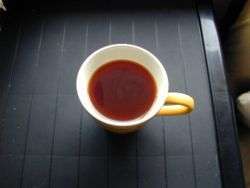
Black tea is Azerbaijan's national drink.
Ayran is a cold yogurt beverage mixed with salt.
An Azerbaijani sherbet (Azerbaijani: şərbət) is a sweet cold drink made of fruit juice mixed or boiled with sugar, often perfumed with rose water. Sherbets (not to be confused with sorbet ices) are of Iranian origin and they may differ greatly in consistency, from very thick and jam-like (as in Tajik cuisine) to very light and liquid, as in Azerbaijan.[13] Sherbets are typically prepared in the following natural flavors:
Locally made brands of bottled water include the following:[15]
| Brand | Origin | Originating area |
|---|---|---|
| Aysu | ||
| Badamlı | Badamli, Nakhchivan | |
| Sirab | Sirab, Nakhchivan | |
| Şollar | Şollar village | North-east |
| Tamiz gazh su | ||
| Qax | Qakh district | North[16] |
| Kakh | ||
See also
References
- ↑ Climate zones of Azerbaijan
- 1 2 Based on the book Azerbaijani Cooking, Ishyg Publ. House, Baku (Russian)
- ↑ Kourma recipe
- ↑
- 1 2 Azerbaijan cookery by category of dishes, a section of Large Guide to Home Cooking (Russian)
- 1 2 Dogramach and ovdukh Archived October 14, 2008, at the Wayback Machine.: recipes for Azerbaijani soups (Russian).
- ↑ Interview with Jabar Mamedov, Head Chef at the "Shirvan Shah" Azerbaijani restaurant in Kiev, 31 January 2005.
- ↑ "Huge pakhlava hits record in Ganja" Archived March 19, 2009, at the Wayback Machine. on anspress.com. Retrieved on 17 March 2009
- ↑
- ↑
- ↑ http://kabobcentral.com/tandoorbpage.html
- ↑ http://www.malatyahaber.com/haberler/templates/malatya-new.asp?articleid=15738&zoneid=7&y=
- ↑ Azerbaijani sherbets
- 1 2 Recipes for lemon and mint sherbets (Russian)
- ↑ Mineral Waters of the World: Azerbaijan Archived December 8, 2008, at the Wayback Machine.
- ↑ Qakh or Kakh mineral water Archived April 2, 2007, at the Wayback Machine.
External links
| Wikibooks Cookbook has a recipe/module on |
- AZ Cookbook: Food from Azerbaijan and Beyond
- Comparison of Cuisine between North and South Azerbaijan, Azerbaijan International, Autumn 2000, pp. 24–27.
- Proverbs about Food in Azerbaijan, Azerbaijan International, Autumn 2000, pp. 36–37.
- Food! Glorious Food!, Special issue of Azerbaijan International, Autumn 2000.
- Azerbaijani dishes: photographs and descriptions
- Azerbaijani cuisine: descriptions of dishes by category on advantour.com
- Cuisine of Azerbaijan based on the book Azerbaijani Cooking published in Baku (Russian)
- Selected recipes from Azerbaijani cuisine
